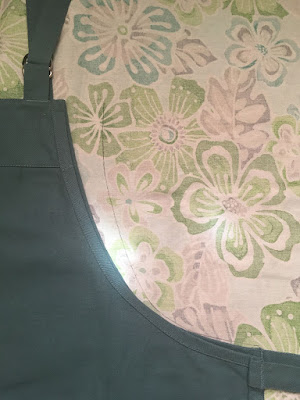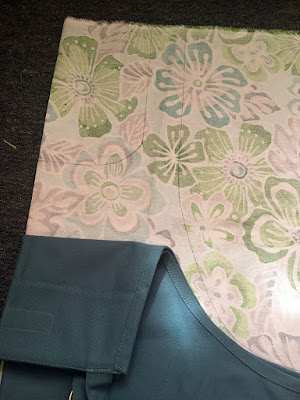I have approximately nine projects going right now, which should shock pretty much no one anymore. In this case, half of them were meant to be
fast projects, which of course means I immediately came up with ways to make them take more time.
 |
| I found a way to get gold foiled fabric into my life. |
I got these fabrics on a whim, because they were on clearance and cost me something like $8.16 total, and I'd been thinking I wanted to get some canvas for a garden apron before harvest season really got going. And they matched. And I am a champion justifier-of-purchases.
 |
| Me, have a limited palette? Nooooo. |
I knew I wanted to make a Japanese-style apron, with crossed straps that just sling over opposite shoulders, so there's nothing to tie or untie. But...I've never made one, nor seen one up close. I spent some quality time lying on the couch, contemplating the backs of my eyelids while I tried to follow the path of the theoretical straps with my hands, working out how everything needed to be arranged for minimal seaming and good fit.
And then I grabbed my cooking apron and started drawing on fabric!
 |
| I promise, there is a faint pattern line there. |
I knew I wanted a wider bib, for slightly more protection from dirt, but I like the height of the "armscye" (so to speak) of my cooking apron, so I traced that for a bit and then swooped the line up more sharply, for an additional two inches or so of width.
 |
| Now I just have to transfer the marks to the other side... |
I also made the straps extra long on the front and side pieces; they'll be easy to adjust shorter, but I don't want to fuss with adding scraps to extend them.
 |
| Don't worry, I have a plan for the mismatched hem. |
The side pieces were...challenging. To get the straps to lay right, I needed to attach the side pieces to the front at an angle. But the side seam was already at an angle. But the back half of the straps sprang straight from the piece, so did it need more angular...angling?
Obviously, I picked a solution and ran with it, again leaving the strap very long, and not fussing with the hem yet. The front piece is definitely longer than I need, and I don't need the back to cover quite so much as a pinafore, so the choppy, mismatched hem is just to take advantage of the selvedge protecting those edges while I flip and turn and otherwise mangle the pieces during construction.
 |
| Not pictured: the man who felt the need to sit exactly next to me in the otherwise-empty laundromat. |
My first try at matching up the straps was right at the ends, just to see how things would hang—that put the seam right on top of my shoulders, and let the sides hang a little looser than I wanted, so the front wanted to flare out away from my body. I cinched up the back straps by about an inch each, and that did the trick. Now the seams are just behind my shoulders, where they won't rub much, and the sides sit a little closer. Again, I left the selvedges in place (along with the absolutely huge seam allowance on the long edges; they're along the grain, so I wanted a bit of security against fraying).
 |
| It took a lot of brain bending in the beginning to work out pattern pieces that would do this gracefully. |
Pretty cute so far, but of course, a garden apron isn't much use without pockets to stow tools, seed packets, and harvested bits (or toads? You never know what you might need to stash in an apron). I have a little more work to do before the apron's done (that gold-dotted fabric hasn't even put in an appearance yet!), so I'll leave it here for now.
 |
| We could make the most darling salad with these. |
This is what happens, by the way, if your arugula bolts. Amazingly, it's still quite edible, though the leaves are pretty strong. I haven't yet harvested the flowers to toss on a salad, but eventually I'll remember to grab some on my way through the garden. The kale hasn't bolted yet (weird), despite 90-degree days, so we're still eating it, too.








Comments
Post a Comment